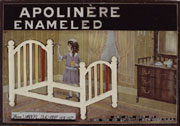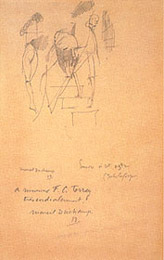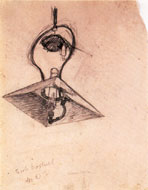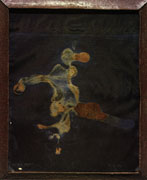|
Moonlight
Becomes You
The lost weekend
Duchamp shares with Apollinaire and Picabia, visiting Gabrielle Buffet-Picabia
and her mother, is nevertheless survived by two important documents:
Apollinaire's 1912 "Zone", named after the region in the Jura
mountains they were visiting, and Duchamp's "La Route Jura-Paris",
also from that year, named after the road they took to get there. Having
only just harrowed every driver's hell--mountain passes in a torrential
storm--Duchamp memorializes the headlights, which he surely confronted
on the road that stormy trip, as the "headlight / lighthouse child"
["enfant-phare"], who is indeed the principal protagonist
in "La Route Jura-Paris" (DDS 41-42; WMD 26-27).(73)
Throughout the text, Duchamp even imparts a telling specificity to the
oncoming direction of these headlights in particular. Yet the
automotive near-collision he stages is not only personified, but also
its protagonists, rather more surprisingly, are nude. "To one side",
as Duchamp explains in "La Route Jura-Paris", the "leader
of the five nudes" is "in front of" the others, "towards"
the road and, himself, a sort of "terminus". "To the
other side", also a sort of "terminus", etc., the "headlight
/ lighthouse child" confronts the "leader of the five nudes"
(DDS 41-42; WMD 26-27).
A lighthouse is
not itself without sexual suggestion, as Breton's important article
on Duchamp specifically emphasizes, "Lighthouse of the Bride"
(1935),(74)
by otherwise inexplicably attributing the lighthouse to the "Bride",
just as Duchamp's Etant Donnés nude is famously possessed of a beacon-like lamp she also holds
aloft. Nor do Duchamp's light sources, any more than Zeus' mighty thunderbolt,
or his golden-shower visitation of Danaë, leave much to the imagination.
As Duchamp explains in his instruction manual for installing Etant
Donnés, "the spotlight should fall vertically, exactly,
on the cunt".(75)
Yet, in exactly this sense, the "headlight / lighthouse child",
as it turns out, is also a "comet", one which, precisely reversing
the natural order of things, instead leads with its fiery tail ["sa
queue en avant"] (DDS 42; WMD 26). As such, Duchamp's
conflation of the headlight / lighthouse / tail-leading comet doubly
emulates Marey's foil-leading fencers. For not only do comet and fencer
each lead with the "tool" ["queue"] of his trade,
but also the tip of that tool--not unlike the fiery spear of Saint Theresa's
"ecstasy", or the bizarrely protuberant, glowing finger of
E.T. --is, in both cases, brightly illuminated.(76)
|
click
to enlarge
|
| |
|
Figure
42
|
|
Marcel
Duchamp, Once More to This Star, 1911
|
Like a moth to a flame,
all these various figurations of headlights, lighthouses and lamps, as
well as the light-tipped "tools" wielded by Duchamp's comet
and Marey's fencers alike, exercise a similar force of attraction, especially,
on the comings and goings of nudes in particular. Thus, in Duchamp's "La
Route Jura-Paris", the headlight / lighthouse / tail-leading comet
all but beats a path to the "leader of the five nudes"; similarly,
in Duchamp's first stab at The Bride Stripped Bare By The Bachelors,
the "phallic barbs" of the "Bachelors"--based on the
light-tipped parry!-thrust! of Marey's fencers--both surround and take
aim at the nude "Bride"; and, no differently, the second Nude,
as it turns out, is exactly the reverse of another nude of just the prior
year--this one, however, ascending a staircase: Encore à cet astre
[Again to This Star] (1911) (Fig. 42).
Duchamp even nicknames the drawing "Nude Ascending A Staircase",
and explains that it "represented a nude going up the stairs, and
it is... the original idea in reverse of the 'Nude Descending'".(77)
As in "La Route Jura-Paris", therefore, we again have two nudes
whose direction relative to each other--whether nearly colliding on a
road, or crossing paths on a staircase--is specifically mediated by a
source of light. Moreover, exactly as Duchamp reverses the direction of
the tail in relation to a comet, he reverses the ascending nude into a
descending nude in relation to a "star". Yet the "star"
to which the one nude ascends, the other nude, according to Duchamp's
logic, already is--or at least possesses. For the descending Nude
need not ascend "to this star", because its "Le Pendu Femelle"
is that fully phallic--light-tipped foil-wielding, headlight /
lighthouse "Bride"-beaconing, tailing-leading comet-shooting--"star".(78)
|
click
to enlarge
|
| |
|
Figure
43
|
|
Marcel
Duchamp, Hanging Gas Lamp (Bec Auer), 1903-4
|
 |
|
Figure
44
|
|
Marcel
Duchamp, Apolinère Enameled, 1917/65
|
For an artist so fundamentally
concerned with the two primary conditions of representation--"sol"
and "soleil": ground and light--that he ubiquitously invaginates
the space of the former, and phallicizes the light of the latter, it is
perhaps unsurprising that, just like the figure-ground problem, a lamp--the
"Bec Auer" --should also illuminate Duchamp's entire career:
from the first drawing he makes of it (1903-04) (Fig.
43), just before finishing lycée and moving to Paris, to the
very thing itself which the Etant Donnés nude holds aloft in the
last decades of his career. Although one could argue that the light-tipped
phallic body of Duchamp's first drawing of the lamp, together with the
vaginal hood it "penetrates", pretty much tells the entire story,
I would like, instead, to approach the "Bec Auer" obliquely,
as inflected by Apolinère Enameled (1917) (Fig.
44). Once a signboard for Sapolin Enamel, the advertising copy
of Apolinère Enameled would have originally read: "Manufactured
by / Gerstendorfer Bros." By eliminating the letter "M",
then eliminating the first letter following each English word so formed
(or nearly so formed), Duchamp transforms the first line of the text from
"Manufactured By" into "M anu f act u red
By": that is, into "An[y] Act Red By". As with his
Ready-mades more generally, "Manufactured" thus becomes a question
of "Any Act": not of making, but rather of choosing the Ready-mades,
of which Apolinère Enameled is one of the "assisted"
variety. In a Nominalist dream come true, "Red" even conflates
the (read) text / (red) image dialectic always at issue in Duchamp's works
anyway: "the difference between speaking about red and looking at
red" (DDS 118 (n. 1); WMD 83), as the artist observes.(79)
Suddenly, however,
the rules change, and what would have originally read "Ger
s ten d or fer Bros."--and, therefore,
should read "[H]er Ten Or Fer Bros."--instead reads "[H]er
Ten Or [Epergne]". Never more appropriately, "Or" is
indeed the turning point, between old rules "or" new ones,
as between what should read "Fer Bros.", but does read "Epergne".
As a Duchamp-style bilingualism, an untranslated "Fer" [Iron],
plus a translated "Bros." ["Frères"], would have
yielded the eminently conceptual, metallurgical-as-metalogical concern:
"Fer Frères et cie."(80)
Like a gaggle of geese, or a pride of lions, an "Epergne"
is exactly this: a "fraternity" of phallic-metallic candlesticks
["Fer Frères"] which, surrounding a large central dish, can
be used as a centerpiece. But if "Or" constitutes a full stop
in the flow of the text, pronounced "Au-Er" in French, it
also refers to Duchamp's beloved-of-youth (Bec) "Auer" lamp.
In addition to the sconce which is clearly observable on the rear wall
of Apolinère Enameled, we therefore have an "Auer"
lamp in the text, which itself presents a choice between two further
lighting fixtures: "Fer Bros." and "Epergne".
If, however, these various lighting fixtures are the prick, where, as
Duchamp says ["où il y a Chaliapine"], is the pussy? It is
"mirrorically returned", right where we should expect to find
it, in the mirror which, beside the sconce, is also set against the
rear wall of Apolinère Enameled. Insofar as "mirrorical
return" constitutes a process of sexual involution (e.g. her urinal
becomes his faucet, or her trough becomes his peak), we should expect
the "spectacular" presence of the sconce to "mirrorically
return" as a spectacular absence. In other words, as a multi-phallic
figuration of his sex, expressly included within the picture, the sconce
should "mirrorically return" not only in an inverted form
(as a unitary, concave figuration of her sex) but also, paradoxically,
as an absence (as something implied by, but no longer expressly included
within the picture). No differently, what the "Epergne" adds
(textually) that the sconce does not contain (visually), a large central
dish, we should likewise expect to "mirrorically return" in
the mirror.
|
click
to enlarge
|
| |
|
Figure
45
|
|
Marcel
Duchamp, Paysage Fautif, 1946
|
This is exactly what
the hair--which Duchamp, seemingly gratuitously, sketches in the mirror--as
a Freudian fetish accomplishes.(81)
As a fetishistic disavowal of sexual difference, the hair dissembles the
absence of her "candlestick" (which is not a young woman's
and, therefore, cannot be in the mirror), by concealing the presence
of her "dish" (which is a young woman's, yet is hidden behind
the hair in the mirror), just as the Bottlerack in some sense both
begs, yet dissembles its bottles. Both the absence of her candlestick
and, conversely, the presence of her dish are likewise disavowed.
The spectacular candlestick "mirrorically returns" as an unspectacular
dish--it invaginates in the mirror, even as the dish it becomes is hidden
by the hair--and, I suppose, all run away with the spoon. No differently,
really, if what separates Duchamp's Virgin from his Bride is, as de Duve argues, the difference of an
"I"--of a "vierge" [virgin] ineffably changed by a
"verge" [penis] --perhaps this is also to say that a "mariée"
[bride] is consummated by a "marée" [swelling tide], and that
her "passage" is a sort of "pa[i]ssage" ["paysage"
= landscape]. In this case, we would have exactly what we do have in Duchamp's
semen on astralon Paysage Fautif [Harem-Scarum Landscape(82)
] (1946) (Fig. 45): for once, the artist
inseminating the ground, rather than invaginating it.
page
1 2 3
4 5 6
Notes
 72. Bettelheim, The Empty Fortress, p. 317. 72. Bettelheim, The Empty Fortress, p. 317.
 73.
Duchamp's "car-as-driver" analogy also informs the Large
Glass, which he describes as "un monde en jaune" = "un
monde engin": "a world engine" (DDS 66; cf.
WMD 44). 73.
Duchamp's "car-as-driver" analogy also informs the Large
Glass, which he describes as "un monde en jaune" = "un
monde engin": "a world engine" (DDS 66; cf.
WMD 44).
 74.
André Breton, "Lighthouse of the Bride" (1935), in Surrealism
and Painting, trans. Simon Taylor (London: MacDonald, 1972) 85-99. 74.
André Breton, "Lighthouse of the Bride" (1935), in Surrealism
and Painting, trans. Simon Taylor (London: MacDonald, 1972) 85-99.
 75.
Marcel Duchamp, Manual of Instructions for Marcel Duchamp, "Etant
Donnés" (Philadelphia: Philadelphia Museum of Art, 1987)
20 (my translation). On Duchamp's similarly phallic use of light in
the Arcane 17 window installation, see Charles Stuckey, "Duchamp's
Acephalic Symbolism", Art in America, vol. 65, no. 1 (Jan.-Feb.
1977): 96. 75.
Marcel Duchamp, Manual of Instructions for Marcel Duchamp, "Etant
Donnés" (Philadelphia: Philadelphia Museum of Art, 1987)
20 (my translation). On Duchamp's similarly phallic use of light in
the Arcane 17 window installation, see Charles Stuckey, "Duchamp's
Acephalic Symbolism", Art in America, vol. 65, no. 1 (Jan.-Feb.
1977): 96.
 76.
In order to produce his time-lapse imagery of "phallic barbs",
Marey thus rigged his foiling-leading fencers with "tiny electric
bulbs" or, at times, with reflective "metal buttons".
See Marta Braun, Picturing Time: The Work of Etienne-Jules Marey,
1830-1904 (Chicago: University of Chicago, 1992) 100 ff, 287-91;
François Dagognet, Etienne-Jules Marey: A Passion for the Trace,
trans. Robert Galeta, Jeanine Herman (N.Y.: Zone Books, 1992) 149-50. 76.
In order to produce his time-lapse imagery of "phallic barbs",
Marey thus rigged his foiling-leading fencers with "tiny electric
bulbs" or, at times, with reflective "metal buttons".
See Marta Braun, Picturing Time: The Work of Etienne-Jules Marey,
1830-1904 (Chicago: University of Chicago, 1992) 100 ff, 287-91;
François Dagognet, Etienne-Jules Marey: A Passion for the Trace,
trans. Robert Galeta, Jeanine Herman (N.Y.: Zone Books, 1992) 149-50.
 77. Duchamp,
Cabanne, Dialogues with Marcel Duchamp, p. 46 (my emphasis). 77. Duchamp,
Cabanne, Dialogues with Marcel Duchamp, p. 46 (my emphasis).
 78.
See Lawrence Steefel, "Marcel Duchamp's Encore à cet astre:
A New Look", Art Journal, vol. 36, no. 1 (Fall 1976):
23-30, where he discusses the possible gender(s) of the nude(s) on
the staircase. See also Bradley Bailey, "Once More to this Staircase:
Another Look at Encore à cet Astre", Tout-Fait: The
Marcel Duchamp Studies Online Journal, vol. 2, no. 4 (January
2002) Articles <http://www.toutfait.com/issues/volume2/issue_4/articles/bailey/bailey1.html>. 78.
See Lawrence Steefel, "Marcel Duchamp's Encore à cet astre:
A New Look", Art Journal, vol. 36, no. 1 (Fall 1976):
23-30, where he discusses the possible gender(s) of the nude(s) on
the staircase. See also Bradley Bailey, "Once More to this Staircase:
Another Look at Encore à cet Astre", Tout-Fait: The
Marcel Duchamp Studies Online Journal, vol. 2, no. 4 (January
2002) Articles <http://www.toutfait.com/issues/volume2/issue_4/articles/bailey/bailey1.html>.
 79.
See de Duve, Pictorial Nominalism, pp. 119-42. 79.
See de Duve, Pictorial Nominalism, pp. 119-42.
 80.
We can similarly translate Duchamp's Pharmacie (1914) as "Phare,
ma cie." 80.
We can similarly translate Duchamp's Pharmacie (1914) as "Phare,
ma cie."
 81. See Freud,
"Fetishism", pp. 152-57. 81. See Freud,
"Fetishism", pp. 152-57.
 82.
Needless to say, I've taken a few liberties with my translation, combining
"fautif" [faulty: harum-scarum] and "faux tifs"
[false body hair: body hair which a harem paradigmatically lacks]. 82.
Needless to say, I've taken a few liberties with my translation, combining
"fautif" [faulty: harum-scarum] and "faux tifs"
[false body hair: body hair which a harem paradigmatically lacks].
Figs.
42-45
©2003 Succession Marcel Duchamp, ARS, N.Y./ADAGP, Paris.
All rights reserved.
|
















